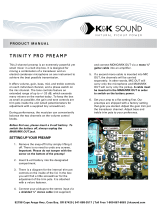IMPORTANT SAFETY INSTRUCTIONS
Before using this unit, be sure to carefully read the applicable items of these operating instructions and the
safety suggestions. Afterwards keep them handy for future reference. Take special care to follow the
warnings indicated on the unit itself, as well as in the operating instructions.
1. Water and Moisture – Do not use the unit near
any source of water or in excessively moist
environments.
2. Object and Liquid Entry – Care should be
taken so that objects do not fall, and liquids are
not spilled, into the enclosure through openings.
3. Ventilation – When installing the unit in a rack
or any other location, be sure there is adequate
ventilation. Improper ventilation will cause
overheating, and can damage the unit.
4. Heat – The unit should be situated away from
heat sources, or other equipment that produce
heat.
5. Power Sources – The unit should be connected
to a power supply only of the type described in
the operating instructions, or as marked on the
unit.
6. Power Cord Protection – AC power supply
cords should be routed so that they are not likely
to be walked on or pinched by items placed upon
or against them. Pay particular attention to cords
at plugs, convenience receptacles, and the point
where they exit from the unit. Never take hold of
the plug or cord if your hand is wet. Always
grasp the plug body when connecting or
disconnecting it.
7. Grounding of the Plug – This unit is equipped
with a 3-wire grounding type plug, a plug having
a third (grounding) pin. This plug will only fit
into a grounding-type power outlet. This is a
safety feature. If you are unable to insert the plug
into the outlet, contact your electrician to replace
your obsolete outlet. Do not defeat the purpose of
the grounding-type plug.
8. Carts and Stands – The unit should be used only
with a cart or stand that is recommended by the
manufacturer. The unit and cart combination
should be moved with care. Quick stops,
excessive force and uneven surfaces may cause
the unit and cart combination to overturn.
9. Wall Or Ceiling Mount – The unit should be
mounted to a wall or ceiling only as
recommended by the manufacturer.
10. Cleaning – The unit should be cleaned only as
recommended by the manufacturer.
11. Nonuse Periods – The AC power supply cord of
the unit should be unplugged from the AC outlet
when left unused for a long period of time.
12. Damage Requiring Service – The unit should be
serviced by a qualified service personnel when:
a) The AC power supply cord or the plug has
been damaged: or
b) Objects have fallen or liquid has been
spilled into the unit; or
c) The unit has been exposed to rain; or
d) The unit does not operate normally or
exhibits a marked change in performance; or
e) The unit has been dropped, or the enclosure
damaged.
13. Servicing – The user should not attempt to
service the unit beyond that described in the
operating instructions. All other servicing should
be referred to qualified service personnel.





















